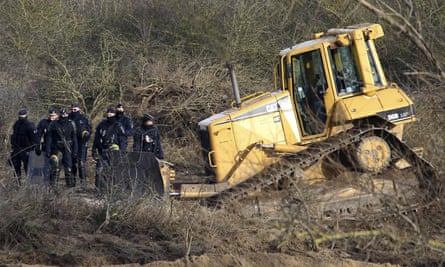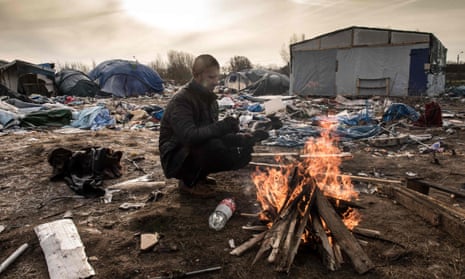It began before dawn, as French police sealed off the main road into the Calais refugee camp. Shortly after first light, a group of around 40 police with riot shields and protective headgear arrived near the south west entrance to the shanty town, home to an estimated 5000 migrants, as a bulldozer began to flatten and clear trees behind them.
But despite protest plans by migrants who threatened to stand their ground by migrants who threatened to stand their ground, the start of the clearance operation to evict an estimated 1,500 people from dwellings in a “buffer zone” marked out by the French prefecture passed off peacefully, largely due to warnings given and to the actions of an army of volunteers, who worked tirelessly throughout the weekend to clear the area.

On Monday, the riot police faced only journalists and a few volunteers across a span of grassland where empty tents, sleeping bags, old clothes and other detritus of human habitation were gently blowing in the freezing wind. A couple of hours later, the police were gone, leaving a lone bulldozer to flatten the land.
“This was the Eritrean area,” said Nico Stevens, of HelpRefugees – one of several organisations involved in the mammoth task of moving purpose-built wooden dwellings from one area of the Jungle to another – pointing to one structure artfully insulated with duvets woven behind wooden walls. A pink Peppa Pig remained on the floor amid a scramble of toys.
“There were lots of women here. They were moved up towards the church.”
Through social media, HelpRefugees were able to call on more than 100 volunteers, many from the UK. Over the last week, people have sent pallets, sleeping bags and even vehicles, to be used to move the migrants safely from the buffer zone.
All 1,500 people have been successfully moved to other parts of the camp, including some 280 women and 40 children. Volunteers and refugees moved over 250 wooden shelters, 300 tents and 40-odd caravans. They worked night and day, building new structures too.
The French authorities want the evictees to move into an alternative, purpose-built facility, which they have created using shipping containers and to reduce the number of migrants at the camp. However, some asylum seekers say they are afraid to transfer to the new camp, as they say it resembles a prison and does not have cooking facilities or communal areas – unlike the Jungle, which has shops, cafes, kitchens, churches and a mosque.

“A lot of volunteers who came had come previously”, said Stevens. “If we asked for sleeping bags, we would get them and we knew that people would be warm the next night.”
Last week, groups representing refugees at the Jungle said police had given them three days’ notice of their proposals to clear an area in which 1,500 people, including many families, had set up home.
However, the deadline was pushed back until Monday, when, following the warning, it became clear evictions were being conducted by refugees themselves and aid groups, including Care4Calais, another group from the UK.
The irony of helping police to do the job of evicting migrants was not lost on many refugee groups.
“We didn’t have an option,” said Émile Poisson, of Acted, the French refugee organisation. “We decided to help, because we couldn’t let women and children who were asking for our help be exposed to violence. If no one had helped they would have been forcibly relocated, exposed to bulldozers and would have been there when the government’s machines came in, risking losing their houses and their belongings,” she said.
However, Poisson, whose organisation runs the water, sanitation and waste collection at the camp, said there was a clear red line they would not cross.
“Our positions is the migrants have to be informed of their rights and it’s their decision if they want to move.”

She said that there would be a danger of further compression of the camp.
“We’ve been able to help people move where they wanted to move, near others in their community. You will see women and children do not leave the family area. But if people are too close together, it could push women and children into areas with single men where they do not feel safe.”
The new purpose-built camp has its pitfalls too. It requires people to have their handprints taken and refugees fear their information will be used to force them to claim asylum in France and so thwart their goal of trying to reach Britain.
Currently, there are 300 people, mainly families, in the containers, according to La Vie Active, who run the facility. Barbara Juokwewycz, spokeswoman for La Vie Active, said they had been processing 50 people a day since last Monday.
“It’s very slow but we have to inform people that although we have some data, it is not data for the police and that they will not have problems with asylum.” she said, adding that the data was for security reasons.
In the camp’s Kabul cafe, where a few people are eating breakfast or keeping warm, one of the community leaders, said they too, had no option but to help clear the buffer zone and relocate people into other areas.
Sikander Noristany, 42, from Afghanistan, who runs the camps’s Kabul cafe and acts as a community leader, said: “We did not change our minds. We cannot stop the government. We didn’t want to move but because of the women and children, we had to. Maybe if we don’t move them, they start destroying homes. There are a lot of women and children in the community. In one day, we cannot find houses for 1,600 people. The kids could die in the cold without a house.”
Noristany had experienced a former dawn raid where “rows and rows of police with riot shields” herded people into the Jungle, destroying the precious few possessions of many, he said.

“Three months ago, there were tents near the bridge, they destroyed them,” he said. “We tried to stop the police, to let them get their possessions, documents and photos but they said no. There were women and children crying.”
Like others in the camp, he was suspicious of the shipping containers.
“In the containers there is just beds for 12 people like animals, like you are in a prison. No washing facility, no food system. They fingerprint you. They want to finish the Jungle. They are making it smaller and smaller and one day it will be finished.”
Some volunteers and refugees spoke of being hit by teargas inside the camp and spent gas canisters could be seen on the ground in the former Kurdish family zone.
Karim Nosrat, 35, a Kurdish Iraqi who fled with his wife and six-year-old son, Raka, because of Isis violence, said he was had been hit by teargas 10 days ago while in his wooden home.
“One night, I had gone outside to the toilet and was coughing and I felt I was nearly dying. My wife opened the door and I felt the burning in my throat and her eyes were stinging. I fell to the floor. I was worried about my young son.”
“People are desperate here. I’ve been here only two months, but some much longer. Every night, people run behind the houses of families, to get to the motorway. They don’t care about dying from a lorry.”
Behind him, through the woods, freight lorries moved along the main motorway, towards the channel tunnel and Britain, where the dreams of most here lie.
Steve Barbet, the police spokesman for the local prefect in Calais, said: “We do not use teargas without a good reason and use of teargas has to be authorised and it is only authorised when it is necessary.”

“Most of the time it’s because the migrants’ camp is just by the port. The road to the port passes just next to it, so they leave the camp either in small groups of 30-50 or sometimes in large groups of 300-400 up to 600-800, they leave the Jungle and go to the road and the throw projectiles on the road to slow down the trucks so they can get into the lorries. Of course we cannot let this happen, we cannot led them block the road, so the police intervene to push them back.”
He said the police try to target the road, but teargas “is not especially precise” and can disperse throughout the camp, a few metres away. He also said that migrants pick up the gas canisters to throw at police.
“It’s not in our interest to use teargas unless it’s absolutely necessary to restore public order, and it is never used in the camp itself.”
Fabienne Buccio, the Calais prefect, said this month that the state’s aim was for “no more migrants sleeping outdoors”.
A spokesman for the prefect’s office said the priority was for migrants to specifically move away from the area of the “Jungle” that is nearest the motorway “for their safety, for the safety of road-users and for the safety of the security forces”. He said the new container shelters were “heated, with real beds and a breakfast served every day”.
The authorities had been working with migrants and local associations to discuss and gradually prepare the move. They had not issued an ultimatum date and, only after the migrants alongside the associations working with them had willingly moved from the area nearest the motorway would the authorities begin to clear that area.
